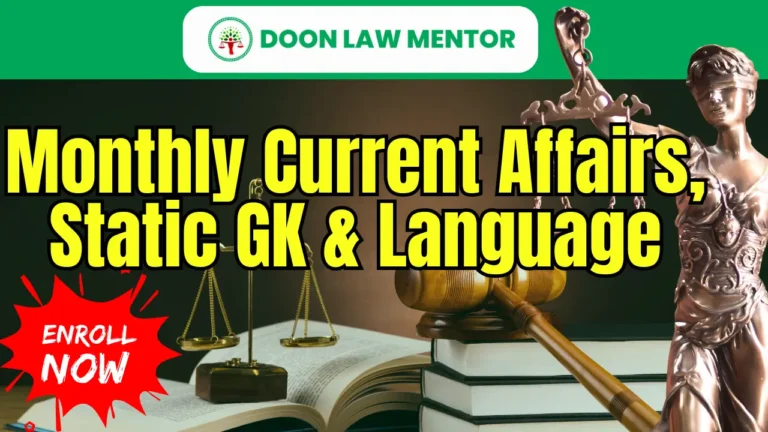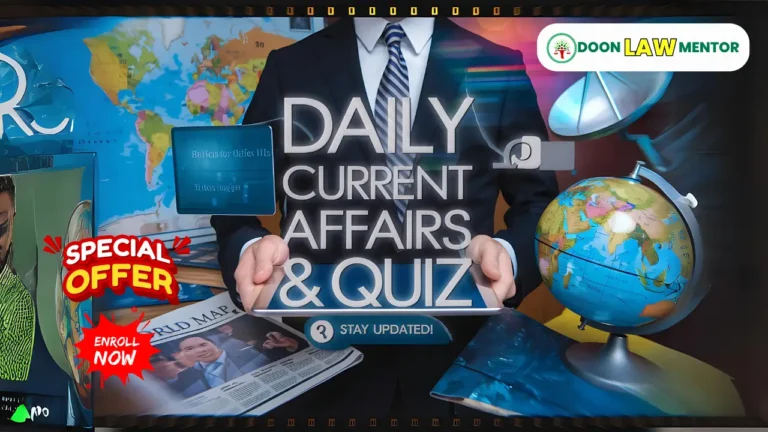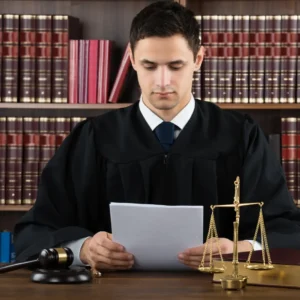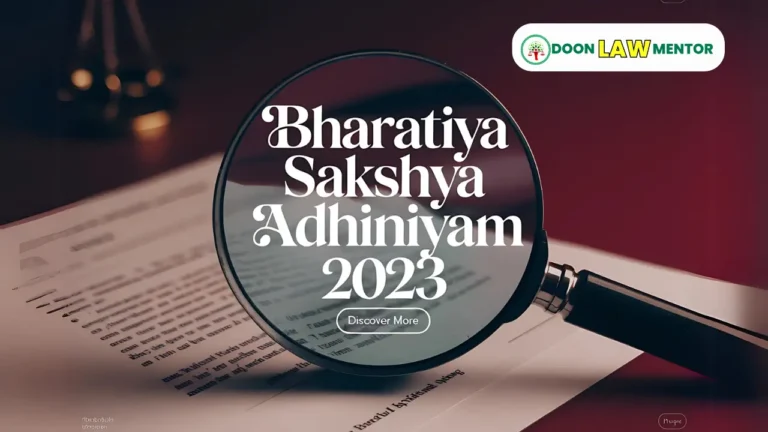The S.R. Bommai Case (S.R. Bommai v. Union of India, AIR 1994 SC 1918) redefined President’s Rule under Article 356, strengthening federalism. Explore the legal issues, Supreme Court’s reasoning, and implications for lawyers and law students with Doon Law Mentor’s expert analysis of this landmark judgment.
Table of Contents
Introduction
Can the Union government dismiss a state government at will? The S.R. Bommai Case (S.R. Bommai v. Union of India, AIR 1994 SC 1918, (1994) 3 SCC 1) answered this critical question. This landmark Supreme Court ruling limited the misuse of President’s Rule under Article 356 and reinforced federalism. For lawyers and law students, understanding the S.R. Bommai Case is essential. It shaped India’s constitutional balance between the Union and states. This article, guided by Doon Law Mentor, provides a detailed legal analysis of the S.R. Bommai Case, its main legal issues, the Court’s observations and reasoning, constitutional framework, and lasting impact.
Historical Background of the S.R. Bommai Case
Context of President’s Rule
The S.R. Bommai Case emerged during a period of frequent misuse of Article 356, which allows the President to impose President’s Rule in a state if its constitutional machinery fails. From 1950 to 1994, Article 356 was invoked over 90 times, often for political reasons. The S.R. Bommai Case addressed this abuse, focusing on dismissals of state governments in the 1980s and early 1990s.
Factual Background
The S.R. Bommai Case involved challenges to President’s Rule in six states: Karnataka, Meghalaya, Nagaland, Himachal Pradesh, Madhya Pradesh, and Rajasthan. In Karnataka, S.R. Bommai’s Janata Dal government was dismissed in 1989 after the central government, led by the Congress party, claimed a breakdown of constitutional machinery due to alleged defections. Similar dismissals occurred in other states. The S.R. Bommai Case consolidated these challenges to examine the validity of Article 356 proclamations.
Constitutional Crisis
The S.R. Bommai Case arose amid tensions between the Union and state governments. The frequent use of Article 356 threatened federalism, a core constitutional principle. The Supreme Court, through a nine-judge bench, sought to clarify the scope of President’s Rule and protect state autonomy in the S.R. Bommai Case.
Read More: Berubari Union Case: Legal Analysis of India’s Territorial Cession
Main Legal Issues in the S.R. Bommai Case
The S.R. Bommai Case (S.R. Bommai v. Union of India, AIR 1994 SC 1918) addressed three main legal issues:
- Scope of Article 356: What are the constitutional limits on imposing President’s Rule under Article 356?
- Judicial Review of Proclamations: Can the Supreme Court review proclamations under Article 356, and if so, on what grounds?
- Federalism and Secularism: Is federalism part of the Constitution’s basic structure, and can President’s Rule be imposed for violating secularism?
These issues centered on the S.R. Bommai Case’s core question: the balance between Union authority and state autonomy under Article 356.
Supreme Court’s Observations, Decisions, and Reasoning
Issue 1: Scope of Article 356
Observation: The Supreme Court observed that Article 356 is an exceptional power, intended for situations where a state’s constitutional machinery has broken down. The S.R. Bommai Case noted that frequent misuse of Article 356 for political motives, such as dismissing opposition-led state governments, undermined federalism. The Court examined whether the Karnataka dismissal and others were justified.
Decision: Article 356 can only be invoked when there is a genuine breakdown of constitutional machinery, not for political convenience. The S.R. Bommai Case held that proclamations must be based on objective material.
Reasoning: The Court reasoned that Article 356 is not absolute. It is subject to constitutional limits, including federalism, a basic structure feature. The S.R. Bommai Case emphasized that the President must act on relevant material, not arbitrary or mala fide grounds. In Karnataka, the dismissal based on alleged defections lacked sufficient evidence, rendering it unconstitutional.
Issue 2: Judicial Review of Proclamations
Observation: The Court observed that Article 356 proclamations involve executive discretion but are not immune from judicial scrutiny. The S.R. Bommai Case considered whether courts can review such proclamations, especially when they infringe on state autonomy or fundamental rights.
Decision: Proclamations under Article 356 are subject to judicial review. The S.R. Bommai Case ruled that courts can strike down proclamations if they are mala fide, based on irrelevant grounds, or violate constitutional principles.
Reasoning: The Court reasoned that judicial review, part of the basic structure per Kesavananda Bharati (AIR 1973 SC 1461), extends to Article 356 proclamations. The S.R. Bommai Case held that courts can examine the material basis for proclamations to ensure compliance with constitutional norms. If the material is irrelevant or the action is politically motivated, the proclamation is invalid. The Court struck down proclamations in Karnataka, Meghalaya, and Nagaland but upheld others.
Issue 3: Federalism and Secularism
Observation: The S.R. Bommai Case examined whether federalism and secularism are part of the Constitution’s basic structure. The Court noted that Article 356’s misuse threatened federalism by undermining state autonomy. It also considered whether violations of secularism, such as in states supporting communal violence, justified President’s Rule.
Decision: Federalism and secularism are part of the Constitution’s basic structure. The S.R. Bommai Case held that President’s Rule can be imposed for failure to uphold secularism but must be supported by objective evidence.
Reasoning: The Court reasoned that federalism, ensuring a balance between Union and state powers, is a core constitutional feature. The S.R. Bommai Case also recognized secularism as a basic structure element, essential for India’s unity. If a state government promotes communalism, it constitutes a breakdown of constitutional machinery, justifying Article 356. However, such action requires clear evidence, as seen in the S.R. Bommai Case’s analysis of state actions.
Additional Observations: Guidelines for Article 356
The S.R. Bommai Case laid down guidelines to prevent misuse of Article 356:
- Proclamations must be based on objective material showing a breakdown of constitutional machinery.
- The Union must issue a warning to the state government before imposing President’s Rule.
- Proclamations require parliamentary approval under Article 356(3), and courts can restore dismissed governments if proclamations are invalid.
- Secularism violations, like promoting communal violence, justify President’s Rule.
The S.R. Bommai Case emphasized that Article 356 is a last resort, not a tool for political vendettas.
Outcome of the S.R. Bommai Case
Majority Ruling
In a unanimous decision, the S.R. Bommai Case (S.R. Bommai v. Union of India, AIR 1994 SC 1918) struck down President’s Rule in Karnataka, Meghalaya, and Nagaland as unconstitutional. It upheld proclamations in other states where evidence supported a breakdown. The Basic Structure Doctrine was applied to protect federalism and secularism.
Bench Composition
The nine-judge bench, led by Justice P.B. Sawant, included Justices Kuldip Singh, J.S. Verma, Yogeshwar Dayal, A.M. Ahmadi, S.C. Agrawal, B.P. Jeevan Reddy, S. Ratnavel Pandian, and K. Ramaswamy. The ruling, delivered on March 11, 1994, was a landmark in constitutional law.
Subsequent Developments
The S.R. Bommai Case reduced the misuse of Article 356. Post-1994, President’s Rule invocations dropped significantly, with only 12 instances between 1994 and 2025. The ruling influenced cases like Rameshwar Prasad (AIR 2006 SC 980), reinforcing judicial oversight.
Case Study: Karnataka Dismissal
Political Context
In Karnataka, S.R. Bommai’s Janata Dal government was dismissed in 1989 after alleged defections reduced its majority. The S.R. Bommai Case examined whether this justified President’s Rule. The central government claimed a breakdown of constitutional machinery.
Legal Implications
The S.R. Bommai Case ruled the dismissal unconstitutional. The Court found no objective evidence of a governance failure, as Bommai was not given a chance to prove his majority. The ruling protected state autonomy.
Sociopolitical Impact
The S.R. Bommai Case restored public trust in federalism. It curbed the Union’s ability to destabilize opposition-led state governments, strengthening democratic governance.
Comparative Analysis: S.R. Bommai Case vs. Other Landmark Cases
Kesavananda Bharati v. State of Kerala (AIR 1973 SC 1461)
The S.R. Bommai Case built on Kesavananda Bharati’s Basic Structure Doctrine. While Kesavananda limited amendment powers, the S.R. Bommai Case applied the doctrine to Article 356, protecting federalism and secularism.
State of Rajasthan v. Union of India (AIR 1977 SC 1361)
The S.R. Bommai Case diverged from State of Rajasthan, which limited judicial review of Article 356 proclamations. The S.R. Bommai Case expanded judicial scrutiny, ensuring constitutional compliance.
Rameshwar Prasad v. Union of India (AIR 2006 SC 980)
The S.R. Bommai Case’s guidelines were reaffirmed in Rameshwar Prasad, which struck down President’s Rule in Bihar for lack of objective material. The S.R. Bommai Case set the precedent for such rulings.
Implications of the S.R. Bommai Case
Strengthened Federalism
The S.R. Bommai Case reinforced federalism as a basic structure feature, protecting state autonomy from arbitrary Union interference.
Judicial Oversight
The S.R. Bommai Case established judicial review as a check on Article 356 misuse, ensuring accountability in executive actions.
Secularism as a Core Principle
The S.R. Bommai Case recognized secularism as part of the basic structure, allowing President’s Rule for communal governance failures.
Read More: Law on Transit Remand in India: BNSS Framework and Raja Raghuvanshi Case Insights
Challenges and Criticisms
Subjective Interpretation
The S.R. Bommai Case’s reliance on “objective material” was criticized for potential subjectivity in assessing constitutional breakdowns.
Political Tensions
The S.R. Bommai Case faced criticism from Union governments for limiting their power over states, creating political friction.
Implementation Challenges
The S.R. Bommai Case’s guidelines require clear evidence, which can be difficult to assess in complex political scenarios.
Table: Key Aspects of the S.R. Bommai Case
| Aspect | Description | Role in S.R. Bommai Case |
|---|---|---|
| Issue 1 | Scope of Article 356 | Limited to genuine constitutional breakdowns, not political motives. |
| Issue 2 | Judicial review | Allowed courts to strike down mala fide proclamations. |
| Issue 3 | Federalism and secularism | Recognized as basic structure features, justifying President’s Rule for violations. |
| Guidelines | Objective material, warnings | Ensured constitutional compliance in Article 356 use. |
This table, created by Doon Law Mentor, summarizes the S.R. Bommai Case’s framework.
Conclusion: A Landmark for Federalism
The S.R. Bommai Case (S.R. Bommai v. Union of India, AIR 1994 SC 1918) is a cornerstone of India’s constitutional law. It limited the misuse of President’s Rule, strengthened federalism, and upheld secularism. For lawyers and law students, the S.R. Bommai Case is a critical study in constitutional governance. It balanced Union authority with state autonomy, shaping India’s federal structure. Join Doon Law Mentor at doonlawmentor.com for expert resources and mock tests to master such landmark cases.
FAQs
What is the S.R. Bommai Case?
The S.R. Bommai Case (AIR 1994 SC 1918) limited President’s Rule under Article 356, protecting federalism and state autonomy.
What is the significance of the case?
The S.R. Bommai Case established judicial review of Article 356 proclamations and recognized federalism as a basic structure feature.
Can President’s Rule be reviewed?
The S.R. Bommai Case held that courts can review Article 356 proclamations for mala fide or irrelevant grounds.
How did it impact secularism?
The S.R. Bommai Case recognized secularism as a basic structure feature, justifying President’s Rule for communal violations.
What are its modern implications?
The S.R. Bommai Case ensures constitutional checks on Article 356, protecting federalism and democratic governance.
#SRBommaiCase #PresidentsRule #Article356 #Federalism #SupremeCourtIndia #DoonLawMentor #judicialSage #JudicialYogi









